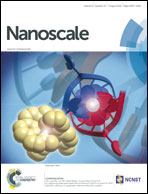Facile route to highly photoluminescent carbon nanodots for ion detection, pH sensors and bioimaging†
Abstract
Carbon nanodots (CDs) of uniform size were prepared simply by the hydrothermal decomposition of folic acid (FA) precursor at various reaction temperatures. The CDs formed via dehydration of FA at 260 °C contributed the strongest photoluminescence (PL) signal and the highest quantum yield at about 68%, without assistance of any passivation agent. The effects of preparation conditions on PL behavior of CDs have been investigated in detail, and the quantum yield of the CDs was found to be associated strongly with sample crystallinity. Moreover, because the obtained CDs also exhibited high luminescence stability, abundant surface functional groups and good biocompatibility, there are many promising applications in printing ink, ion detection, pH sensors and cell imaging.


 Please wait while we load your content...
Please wait while we load your content...